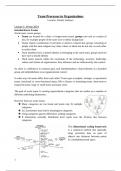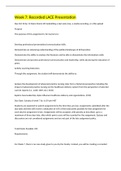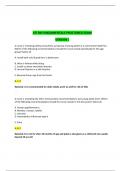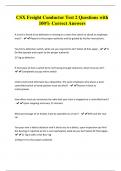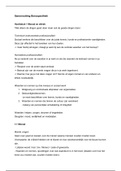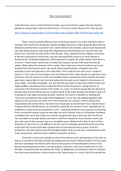Team Processes in Organizations
Lecturer: Wendy Andrews
Lecture 1: 04 sep 2024
Introduction to Teams
Work teams versus groups:
Teams are formed for a short- or longer-term reason, groups can exist as a matter of
fact, for example people of the same race or ethnic background
Teams require coordination of activities to achieve a shared aim, groups consisting of
people with the same religion may share values or ideals not do not rely on each other
to realize them
Team members have a shared identity as belonging to the same team, groups need not
have such a shared identity
Work teams operate within the constraints of the technology, structure, leadership,
culture and climate of organizations, they influence and are influenced by this context
So, there is a difference in common goal, task interdependence, shared identity as a bounded
group and embeddedness in an organizational context.
In what ways do teams differ from each other? Team types examples: strategic vs operational
teams, functional vs cross-functional teams, HR vs finance vs marketing teams, short-term vs
long-term teams, large vs small teams and many more.
The goal of work teams is creating superordinate categories that are similar on a number of
different underlying dimensions.
However there are some issues:
Many categories are too broad and teams may fit multiple
categories
2x2 taxonomies may lead to meaningless categories
Using categories ignores differences withing categories
If dimensions normally distributed most teams near the division line between
categories
This dimensional scaling framework
is a statistical method that optimally
maps proximity data on pairs of
objects into distances between points
in a multidimensional space.
1
,The data is expressing the similarity or the dissimilarity of pairs of subject. There are usually
two or three dimensions.
Why would anyone study teams?
Work in organizations are increasingly performed in teams
The nature of teamwork is changing and becoming increasingly complex, there is
more knowledge-based, virtual, increasing diversity and multiple team membership
We’re learning about new and different things about teams: shift research from SP to
OP/OB, more focus on tasks and technology
Key points from Hollenbeck et al. (2012): why it is better to distinguish teams along
dimensions than categories, understand the model introduced in the paper and the three
dimensions that are part of it and understand the managerial implications of the model.
Three crucial dimensions emerge across different team type taxonomies
Skill differentiation: the degree to which members have specialized knowledge or
functional capacities that make it more or less difficult to substitute members
Authority differentiation: the degree to which decision-making responsibility is
vested in individual members versus the group as a whole
Temporal stability: the degree to which team members have a history of working
together in the past and an expectation of working together in the future
Hollenbeck et al. (2012) state that different
types of teams can be differentiated along the
mentioned three dimensions.
The figure on the left states the managerial
implications of working with teams where there
is either a high or low level of one dimension.
Lecture 2: 06 sep 2024
Team Development Interventions
Team development steps:
Problem identification and selecting a diagnosis tool, the right diagnosis tool can help
you select the right diagnosis and make a problem-solving intervention
Team diagnosis, share your feedback with the team
Plan and prepare a team development intervention, to help the team improve, these
interventions increase effective team competencies and processes, thereby leading to
improvements in proximal and distal outcomes
Implement team development intervention and evaluate the effectiveness of the
intervention
2
, How to identify a problem, some questions to ask: what do you know about the other team?
What type of problems to teams of this type often face? Are there tools that can help you find
out to what extent they face this problem?
The enneagram of personality is a pseudoscientific model of the human psyche which is
principally understood and taught as a typology of nine interconnected personality types
However, this model is not validated and there is no
evidence that the claims that are being made are
actually true
So, this is not a right tool to use for a team
diagnosis
This belongs to the pseudoscientific theories that
cannot be tested because they are so vague and
malleable that anything relevant can be shoehorned
to fit the theory
Pseudoscience consists of statements, beliefs or practices that claim to be both scientific and
factual but are incompatible with the scientific method, so the findings are falsely claimed as
being scientifically true.
The Myers-Briggs Type Indicator (MBTI) is a pseudoscientific self-report questionnaire
that claims to indicate differing psychological types, however, there is a low level of validity
and reliability so it is not a good tool to measure personality
It was designed to help people understand personality
differences in the general population and to show that there are no
‘better’ or ‘worse’ personality preferences
The test assigns a binary value to each of the four
categories: introversion vs extraversion, sensing vs intuition, thinking
vs feeling and judging vs perceiving
One letter from each categories is taken to produce a
four-letter test result representing a possible personality type
Personality configurations (combinations) predicts performance:
For example, adding narcissistic individuals to a team first improves the creativity of
the group process and product and then decreases it again
Another example, adding relatively introverted people to a team of extraverted people
increases their performance and vice versa
How do you know what the personality configuration of a team is? Team diagnosis!
The team diagnostic model is a framework that evaluates teams based on two dimensions:
productivity and positivity.
There are two fundamental ways of diagnosing a team:
3
Lecturer: Wendy Andrews
Lecture 1: 04 sep 2024
Introduction to Teams
Work teams versus groups:
Teams are formed for a short- or longer-term reason, groups can exist as a matter of
fact, for example people of the same race or ethnic background
Teams require coordination of activities to achieve a shared aim, groups consisting of
people with the same religion may share values or ideals not do not rely on each other
to realize them
Team members have a shared identity as belonging to the same team, groups need not
have such a shared identity
Work teams operate within the constraints of the technology, structure, leadership,
culture and climate of organizations, they influence and are influenced by this context
So, there is a difference in common goal, task interdependence, shared identity as a bounded
group and embeddedness in an organizational context.
In what ways do teams differ from each other? Team types examples: strategic vs operational
teams, functional vs cross-functional teams, HR vs finance vs marketing teams, short-term vs
long-term teams, large vs small teams and many more.
The goal of work teams is creating superordinate categories that are similar on a number of
different underlying dimensions.
However there are some issues:
Many categories are too broad and teams may fit multiple
categories
2x2 taxonomies may lead to meaningless categories
Using categories ignores differences withing categories
If dimensions normally distributed most teams near the division line between
categories
This dimensional scaling framework
is a statistical method that optimally
maps proximity data on pairs of
objects into distances between points
in a multidimensional space.
1
,The data is expressing the similarity or the dissimilarity of pairs of subject. There are usually
two or three dimensions.
Why would anyone study teams?
Work in organizations are increasingly performed in teams
The nature of teamwork is changing and becoming increasingly complex, there is
more knowledge-based, virtual, increasing diversity and multiple team membership
We’re learning about new and different things about teams: shift research from SP to
OP/OB, more focus on tasks and technology
Key points from Hollenbeck et al. (2012): why it is better to distinguish teams along
dimensions than categories, understand the model introduced in the paper and the three
dimensions that are part of it and understand the managerial implications of the model.
Three crucial dimensions emerge across different team type taxonomies
Skill differentiation: the degree to which members have specialized knowledge or
functional capacities that make it more or less difficult to substitute members
Authority differentiation: the degree to which decision-making responsibility is
vested in individual members versus the group as a whole
Temporal stability: the degree to which team members have a history of working
together in the past and an expectation of working together in the future
Hollenbeck et al. (2012) state that different
types of teams can be differentiated along the
mentioned three dimensions.
The figure on the left states the managerial
implications of working with teams where there
is either a high or low level of one dimension.
Lecture 2: 06 sep 2024
Team Development Interventions
Team development steps:
Problem identification and selecting a diagnosis tool, the right diagnosis tool can help
you select the right diagnosis and make a problem-solving intervention
Team diagnosis, share your feedback with the team
Plan and prepare a team development intervention, to help the team improve, these
interventions increase effective team competencies and processes, thereby leading to
improvements in proximal and distal outcomes
Implement team development intervention and evaluate the effectiveness of the
intervention
2
, How to identify a problem, some questions to ask: what do you know about the other team?
What type of problems to teams of this type often face? Are there tools that can help you find
out to what extent they face this problem?
The enneagram of personality is a pseudoscientific model of the human psyche which is
principally understood and taught as a typology of nine interconnected personality types
However, this model is not validated and there is no
evidence that the claims that are being made are
actually true
So, this is not a right tool to use for a team
diagnosis
This belongs to the pseudoscientific theories that
cannot be tested because they are so vague and
malleable that anything relevant can be shoehorned
to fit the theory
Pseudoscience consists of statements, beliefs or practices that claim to be both scientific and
factual but are incompatible with the scientific method, so the findings are falsely claimed as
being scientifically true.
The Myers-Briggs Type Indicator (MBTI) is a pseudoscientific self-report questionnaire
that claims to indicate differing psychological types, however, there is a low level of validity
and reliability so it is not a good tool to measure personality
It was designed to help people understand personality
differences in the general population and to show that there are no
‘better’ or ‘worse’ personality preferences
The test assigns a binary value to each of the four
categories: introversion vs extraversion, sensing vs intuition, thinking
vs feeling and judging vs perceiving
One letter from each categories is taken to produce a
four-letter test result representing a possible personality type
Personality configurations (combinations) predicts performance:
For example, adding narcissistic individuals to a team first improves the creativity of
the group process and product and then decreases it again
Another example, adding relatively introverted people to a team of extraverted people
increases their performance and vice versa
How do you know what the personality configuration of a team is? Team diagnosis!
The team diagnostic model is a framework that evaluates teams based on two dimensions:
productivity and positivity.
There are two fundamental ways of diagnosing a team:
3

